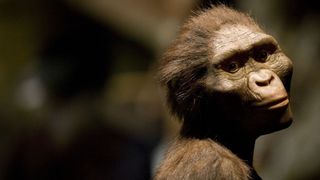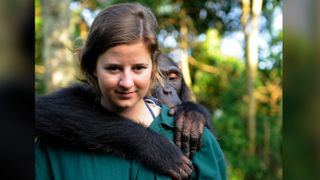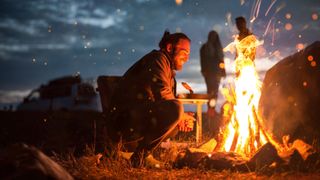Top 10 things that make humans special
This is what sets us apart from the rest of the animal kingdom.

Humans are unusual animals by any stretch of the imagination. Our special anatomy and abilities, such as big brains and opposable thumbs, have enabled us to change our world dramatically and even launch off the planet. There are also odd things about us that are, well, just special compared with the rest of the animal kingdom. So what exactly makes us so special? Some things we take for granted might surprise you.
1. Speech

No one enjoys a good gab session like humans. But why can't apes, our closest living relatives, talk like us? After all, the shape and function of the larynx and vocal tract are fairly similar across primates, comparative studies have found.
To answer this question, look no further than the brain.
Primates tend to have a wider vocal repertoire when two features of the brain — the cortical association areas that control voluntary control over behavior, and the brainstem nuclei involved in control of muscles governing vocal production — are larger, a 2018 study in the journal Frontiers in Neuroscience found. In humans, these features are larger than in other primates.
"In simple terms, primates with bigger cortical association areas tended to make more sounds," study co-researcher Jacob Dunn, an associate professor of evolutionary biology at Anglia Ruskin University in the United Kingdom, wrote in The Conversation. Other factors, such as genetics and the anatomy of the vocal tract, likely also have an effect, and research into their relation to speech is ongoing.
2. Upright posture

Humans are unique among primates because our chief mode of locomotion is walking fully upright. This way of moving frees our hands up for using tools. Unfortunately, the changes made in our pelvis to help us move on two legs, in combination with babies with large brains, makes human childbirth unusually dangerous compared with the rest of the animal kingdom.
Unlike other primates, humans have a lumbar curve in the lower back, which helps us maintain our balance as we stand and walk, but it also leaves us vulnerable to lower back pain and strain, Live Science previously reported.
3. Nakedness

We look naked compared with our hairier ape cousins. Surprisingly, however, a square inch of human skin, on average, possesses as many hair-producing follicles as a chimpanzee's (Pan troglodytes) skin, a 2018 study in the Journal of Human Evolution found. It's just that humans often have thinner, shorter, lighter hairs on most of our bodies than most primates do, so it's easy to think of us as "naked."
So, why are humans covered with short, nearly invisible hair? About 2 million years ago, an adaptation caused members of the genus Homo to miniaturize body hair, while another adaptation increased the number of eccrine sweat glands, which most mammals have only on their palms and the soles of their feet, Live Science previously reported. These adaptations made it easier for Homo to cool off while running long distances because of the exceptional ability to sweat a lot.
If humans were covered with thick hair, like apes are, sweat would coat the hair, which would make it harder for the sweat to evaporate, which is how sweat cools us off. It's a good thing we have miniaturized hair; it makes cooling off a breeze.
Fun fact about hair: Even though we don't seem to have much, it apparently helps us detect parasites, according to a 2011 study in the journal Biology Letters.
4. Clothing

Humans may be called "naked apes," but most of us wear clothing, a characteristic that makes us unique in the animal kingdom. Chimpanzees have been documented adorning themselves with items — one wild chimp wore a knotted skin "necklace" made from the leftovers of a slain red colobus monkey, a 1998 report found, while a captive chimp in Zambia started wearing grass "earrings" that she had draped over her ears, a fashion trend that spread to her fellow chimps — but these adornments didn't protect or insulate the chimps from the elements like human clothes do.
The development of human clothing has even influenced the evolution of other species — body lice (Pediculus humanus humanus), unlike all other kinds, cling to clothing, not hair.
We've also invented clothing for animals, who, truth be told, don't always enjoy getting dressed up.
5. Extraordinary brains

Without a doubt, the human trait that sets us farthest apart from the animal kingdom is our extraordinary brain. One of the human brain's most prized regions is the overdeveloped cerebral cortex; it represents over 80% of our brain mass and is thought to contain 100 billion neurons, according to a 2009 study in the journal Frontiers in Human Neuroscience. The cerebral cortex is associated with complex, higher thinking, such as decision-making, executive control, emotional regulation and language. Even though the human brain makes up about 2% of body weight, it consumes more than 25% of our body's overall energy, a 2018 study in the Journal of Human Evolution reported.
Humans don't have the largest brains in the world — those belong to sperm whales. Yet the human brain, weighing only about 3 pounds (1.3 kilograms) in adults, gives us the ability to reason and think on our feet beyond the capabilities of the rest of the animal kingdom.
6. Hands

Contrary to common misconceptions, humans are not the only animals to possess opposable thumbs — most primates do. (And unlike humans, the rest of the great apes even have opposable big toes on their feet.) What makes humans unique is how we can bring our thumbs all the way across the hand to our ring and little fingers. In other words, our opposable thumbs are much longer than other primate thumbs, according to the American Museum of Natural History (AMNH) in New York.
Our long thumbs and their ability to easily touch other fingers helps us firmly grasp and manipulate objects. We also have fine muscle control, meaning we can do wildly different activities with our hands, such as throw a curveball or hold a pen to sign our names, according to the AMNH.
7. Fire

Humans' ability to control fire brought a semblance of day to night, helping our ancestors to see in an otherwise dark world and keep nocturnal predators at bay. The warmth of the flames also helped people stay warm in cold weather, enabling us to live in cooler areas. And of course it gave us cooking, which some researchers suggest influenced human evolution — cooked foods are easier to chew and digest, perhaps contributing to reductions in human tooth and gut size.
There is evidence that humans used fire as far back as 1 million years ago, but archaeological evidence shows it became more widespread in Africa, Asia, Europe and the Middle East about 400,000 years ago, Live Science previously reported.
8. Blushing

Humans are the only species known to blush, a behavior Charles Darwin called "the most peculiar and the most human of all expressions." It remains uncertain why people blush, involuntarily revealing our innermost emotions (though we do know how it works).
From an evolutionary perspective, perhaps blushing signals that someone has messed up but is acknowledging their mistake to avoid a confrontation. It could also be an indicator of emotional intelligence, Ray Crozier, an honorary professor at Cardiff University's School of Social Sciences in the United Kingdom, told the BBC.
"A prerequisite for embarrassment is to be able to feel how others feel — you have to be empathetic, intelligent to the social situation," Crozier said.
9. Long childhoods

Humans must remain in the care of their parents for much longer than other living primates. For instance, humans take nearly twice as long as chimpanzees to mature, and it looks like our ancient human relatives, such as the 3.2 million-year-old australopithecine Lucy and a 1.6 million-year-old Homo erectus boy, reached adulthood faster than modern humans do, Science magazine reported.
The question then is why do modern humans take so long to mature, when it might make more evolutionary sense to grow as fast as possible to have more offspring? The explanation may be our large brains, especially its high number of cortical neurons; other animals with large numbers of neurons in the cerebral cortex, such as some birds and mammals, also have long childhoods and extensive longevity, a 2018 study in the Journal of Comparative Neurology found.
"It makes sense that the more neurons you have in the cortex, the longer it should take a species to reach that point where it's not only physiologically mature, but also mentally capable of being independent," Suzana Herculano-Houzel, author of the 2018 study and an associate professor of psychology at Vanderbilt University, said in a statement. "The delay also gives those species with more cortical neurons more time to learn from experience, as they interact with the environment."
10. Life after children

Most animals reproduce until they die, including the frisky marsupials known as dusky antechinuses (Antechinus vandycki), whose males mate in a marathon frenzy until they drop dead, as well as many species of octopus, whose males die shortly after mating and whose females die after tending to their eggs.
But in humans, females can survive long after ceasing reproduction. This might be due to the social bonds seen in humans — in extended families, grandparents can help ensure the success of their families long after they have passed the age when they themselves can have children. The so-called "grandmother effect" is real; an analysis of births and deaths between 1731 and 1890 in Finland showed that babies had an increased chance of survival if their maternal grandmothers were between 50 and 75 years old, likely because the grandmas helped with child rearing, a 2009 study in the journal Current Biology found.
Editor's Note: Originally published in 2011. Updated in March 2016 and February 2022.
Additional resources
- Learn more about human evolution at The Smithsonian's Human Origins Program
- Peruse the latest findings at the Max Planck Institute for Evolutionary Anthropology
- Read the latest anthropology news written by scientists around the world at The Conversation.
Bibliography
Dunn, J.C., Smaers, J.B., Frontiers in Neuroscience, 2018
Fitch, W.T. Trends in Cognitive Sciences, 2000
Dunn, J.C., "Why apes can't talk: our study suggests they've got the voice but not the brains" The Conversation, Aug. 10, 2018
Kamberov, Y.G. et al. Journal of Human Evolution, 2018.
Dean, I., Siva-Jothy, M.T., Biology Letters, 2011
McGrew, W.C., Marchant, L.F., Pan Africa News, 1998
Dye, L., "Did a Chimp Invent Jewelry?" ABC News, 2014
Herculano-Houzel, S. Frontiers in Human Neuroscience, 2009
Jawabri K.H., Sharma S. Physiology, Cerebral Cortex Functions, NIH Books, 2022
Boyer, D.M. Journal of Human Evolution, 2018
"The Grasping Hand," American Museum of Natural History, accessed January 2022
Coughlan, S., "Too hot to handle," BBC, 2007
Gibbons, A. "Neandertals, like humans, may have had long childhoods," 2017
Herculano-Houzel, S. The Journal of Comparative Neurology, 2018
Wolf, A. "Why does it take humans so long to mature compared to other animals? Look to your neurons!" Vanderbilt University Research News, 2018
Chapman, S.N. et al. Current Biology, 2019
Sign up for the Live Science daily newsletter now
Get the world’s most fascinating discoveries delivered straight to your inbox.

Laura is the archaeology and Life's Little Mysteries editor at Live Science. She also reports on general science, including paleontology. Her work has appeared in The New York Times, Scholastic, Popular Science and Spectrum, a site on autism research. She has won multiple awards from the Society of Professional Journalists and the Washington Newspaper Publishers Association for her reporting at a weekly newspaper near Seattle. Laura holds a bachelor's degree in English literature and psychology from Washington University in St. Louis and a master's degree in science writing from NYU.
- Charles Q. ChoiLive Science Contributor